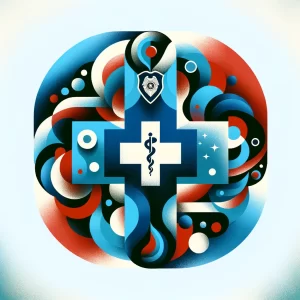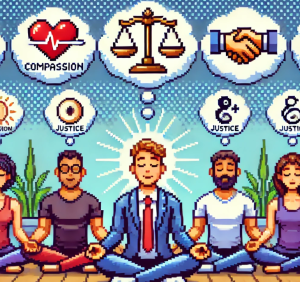
The Dark Web of Sexual Exploitation Ecosystems
In the shadows of everyday life, far from the eyes of most, a sinister ecosystem flourishes—a network where human lives are commodified for profit. Recent research into organized crime has revealed a chilling reality: the exploitation of individuals for sexual services is not just a byproduct of criminal activity but an intricately organized system. This blog explores these findings, unraveling how this ecosystem operates, why it thrives, and what it means for society.
Understanding the Ecosystem of Sexual Exploitation
Think of an ecosystem in nature: different organisms interact, relying on each other for survival. Similarly, in the world of organized crime, various actors play distinct roles that sustain the exploitation of vulnerable individuals. In this context, the term “ecosystem” captures the complex, interconnected relationships that make such exploitation possible.
This ecosystem comprises four main groups: the organizers (criminal networks), the marketers (those who advertise the services), the exploited (the victims), and the buyers (those who purchase sexual services). These groups work together, often unknowingly, to maintain a system where human beings are treated as commodities.
The Organizers: Masterminds of Exploitation
At the heart of this ecosystem are organized crime groups (OCGs) who orchestrate the exploitation. These groups are not just random collections of criminals but well-organized entities with clear business strategies. They recruit vulnerable individuals, often through promises of a better life or financial stability, only to trap them in a cycle of abuse and exploitation.
The research highlights how these criminal networks are sophisticated in their operations, employing tactics that ensure their activities remain hidden from law enforcement. They control every aspect of their victims’ lives, from their movements to their finances, creating a sense of dependency and fear that makes escape nearly impossible.
For instance, the research found that OCGs often distance themselves from direct involvement, operating from abroad or through intermediaries. This makes it incredibly difficult for law enforcement to identify and prosecute the key players, as the criminals are rarely in the same location as their victims.
The Marketers: Facilitating the Exploitation
Marketers in this ecosystem are not the traditional advertisers you might imagine. Instead, they are the operators of Adult Service Websites (ASWs), platforms where sexual services are advertised. While some of these services are consensual, many are not. The challenge lies in distinguishing between the two, a task that ASWs often fail to prioritize.
The study found that many ASWs lack robust verification processes, allowing traffickers to post false advertisements that portray victims as willing participants. This anonymity and lack of regulation create a fertile ground for exploitation. Even more troubling is the reluctance of some ASWs to cooperate with law enforcement, likely due to concerns about losing revenue if exploitative content is removed.
One police officer interviewed in the study remarked on the significant barriers law enforcement faces when trying to obtain information from ASWs, noting that cooperation is often minimal and comes only after numerous bureaucratic hurdles have been cleared.
The Exploited: Trapped in a Web of Deceit
The individuals at the center of this ecosystem are the exploited—the victims who are coerced, manipulated, and trapped in a life of forced sexual labor. These victims often come from vulnerable backgrounds, driven by economic desperation or the hope of a better life. The OCGs exploit these vulnerabilities, luring individuals with promises that quickly turn into nightmares.
Once trapped, these individuals face a bleak reality. Their identification documents are often confiscated, leaving them unable to escape or seek help. The fear of violence, both against themselves and their loved ones, further entrenches their situation.
Alarmingly, the study found that many victims do not perceive themselves as such, often because the alternatives—returning to poverty or facing the legal system as an illegal immigrant—seem even worse. This mindset is a significant barrier to law enforcement efforts, as victims are reluctant to cooperate with authorities, fearing deportation or further abuse.
The Buyers: Unwitting Participants in Exploitation
The final piece of this ecosystem puzzle is the buyers—those who purchase sexual services. Many buyers are unaware that the individuals they are engaging with are victims of exploitation. They see the transactions as consensual and fail to recognize the signs of coercion or trafficking.
The study suggests that educating buyers about the realities of sexual exploitation could be a crucial step in disrupting the ecosystem. By raising awareness of the indicators of trafficking and encouraging responsible actions, it may be possible to reduce demand and, in turn, the profitability of the exploitation business.
However, the research also points out the challenges in this approach. Many buyers fear the stigma associated with purchasing sex and are reluctant to report suspicious activities, preferring to maintain their anonymity.
Disrupting the Ecosystem: A Complex Challenge
The ecosystem of sexual exploitation is a formidable adversary for law enforcement and policymakers. The research highlights several weaknesses in the current legal framework that allow this system to persist. For example, the difficulty in prosecuting OCGs under existing modern slavery laws, coupled with the criminalization of victims as illegal immigrants, creates a situation where the risks of exploitation are low, and the rewards are high for traffickers.
Moreover, the lack of cohesive regulation around ASWs allows these platforms to operate with impunity, further enabling the exploitation of vulnerable individuals. The study calls for more stringent laws and better cooperation between ASWs and law enforcement to prevent traffickers from hiding their activities in plain sight.
A Call to Action
The findings of this research are a stark reminder of the ongoing battle against human trafficking and sexual exploitation. As a society, we must recognize that these crimes are not isolated incidents but part of a broader ecosystem that thrives on vulnerability, anonymity, and impunity.
Addressing this issue requires a multifaceted approach. It involves not only strengthening laws and law enforcement efforts but also educating the public, particularly those who might unknowingly contribute to the demand for such exploitation. By understanding how this ecosystem operates, we can begin to disrupt it, piece by piece, and protect those who are most vulnerable.
Join the Conversation
- What do you think are the most effective strategies for disrupting the ecosystem of sexual exploitation?
- How can public awareness campaigns be designed to better educate potential buyers about the realities of trafficking and exploitation?
Be Part of the Change – Get Weekly Updates!
Stay informed and connected. Subscribe for free and share this blog to make a difference in public health with others. If you liked this blog, please share it! Your referrals help This Week in Public Health reach new readers.



